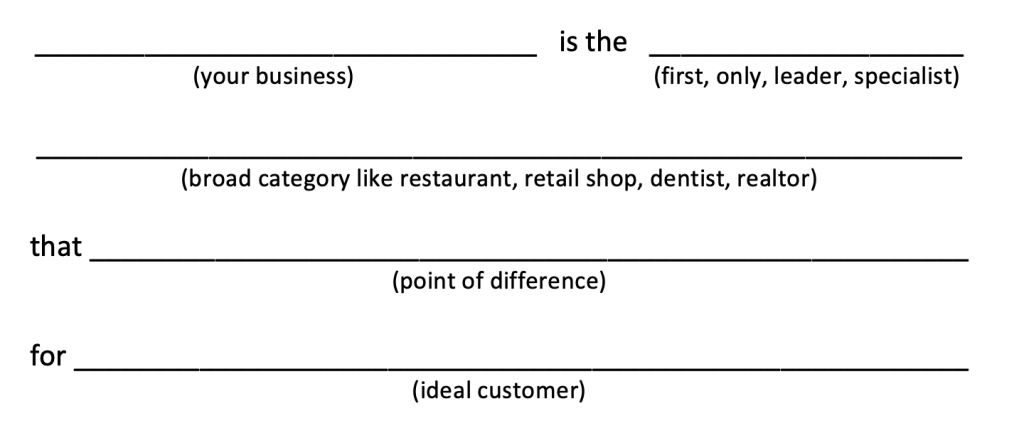Typically, when asked what makes you different, most will say “our people, our customer service”, or restaurants will add, “our food”. Unfortunately, “that’s not good enough to differentiate yourself from the competition.”
Your competition also has great people, service, (and food), that’s why they’re your competition!
When thinking about how to differentiate from the competition, make sure your message is something that no one else can claim — something you can take ownership of. Something that is uniquely you.
It’s imperative to start this process with clarity on these two things:
1. Knowing your business – this is not about your sales or profit numbers, it’s about who you are, what you do, and why you do it.
2. Knowing your competition – you need to not only know who they are, but how they publicly talk about themselves.
For purposes of this discussion, we will assume that you have (1) gone through a formal brand strategy process, so you are clear on the who, what, and why. And (2), done a thorough competitor analysis so you know what your market is saying. Once armed with this information, you can work through the following three steps to craft a strategy and write a positioning statement.
This is not as easy as it may sound!
The first step in our process is to determine which of the 7 categories below you can claim. The goal is to choose the strongest category (just one) that fits your business. This needs to be not only authentic, but a bold promise to your customers that transcends price.
We chose some well-known brand examples because you are familiar with their advertising. But you don’t have to be a huge brand to claim the best category to differentiate yourself from the competition.
- Can you own an Attribute?
Volvo: Safety
Crest: Cavity prevention - Do you have a Magic Ingredient? (If you offer a service rather than a product, you may think the “magic ingredient” doesn’t apply to you, but think again. Isn’t it possible to add a magic ingredient to customer service to bring it above the norm? Or, add a magic ingredient to your consulting services that will make you stand out?)
KFC: The Colonel’s secret recipe of 11 herbs and spices
Chrysler: Hemi engine - Are you the First? (This is one of the best categories to claim if it applies.)
NyQuil: The first nighttime cold medicine
Apple iPod: The first portable electronic device for playing and storing digital audio files - Are you the Latest? (If you can’t be the first, can you improve on the category leader by being the latest?)
Advil: Advanced medicine for pain
Uber: The next generation taxi service - Can you Lead a category? (If you are not the leader in your main service area, is there something else your customer cares about that you can be the leader in?)
Amazon: Leading online retailer
Neutrogena: #1 Dermatologist recommended - Are you a Specialist? (If no one in your market is claiming to be the specialist, you can claim it! This is why it is so important to see what your competitors are saying, or not saying, as the case may be.)
Mayo Clinic: The specialist in hard to diagnose/treat medical issues
Murad: Specialist in dermatologist-developed skin care products - Can you position Against the Competition?
Avis: “We’re number 2, we try harder.”
7up: The un-cola
The next step in our process is to use this brand tool to craft your unique positioning statement.

To further illustrate how this works, here are a few real examples of positioning statements we worked together with our clients to develop:
BuzzRock Brewing Co. is the only local brewery that collaborates with famous rock bands and celebrities for craft beer enthusiasts and the celebrity’s fans.
The After Bar is the first protein bar that contains non-hemp derived CBD with 0% THC for serious athletes seeking muscle recovery.
The last step is to help our clients develop a plan to use their positioning statement concisely and consistently across all marketing platforms. This includes their website, email marketing, social media, and print materials, as well as internal sales scripts and customer service strategies.
Hopefully, these examples help you to understand the process we use to differentiate yourself from the competition. It is, of course, an over-simplified breakdown of an important strategy process that is very often difficult to go through internally.
If you’ve been thinking that you need to position (or re-position) your business uniquely, now may be the best time to schedule a free brainstorming session. We love sharing our expertise and 25+ years of experience helping brands stand out from the competition.
